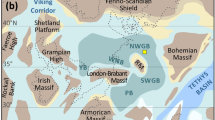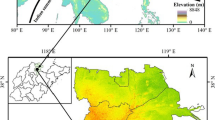Abstract
A cool period from about 11000 to 10 500 BP (11 to 10.5 ka) is recognized in pollen records from the southern Great Lakes area by the return of Picea and Abies dominance and by the persistence of herbs. The area of cooling appears centred on the Upper Great Lakes. A high-resolution record (ca. 9 mm/y) from a borehole in eastern Lake Erie reveals, in the same time interval, this pollen anomaly, isotope evidence of meltwater presence (a — 3 per mil shift in σ18O and a +1.1 per mil shift in σ13C), increased sand, and reduced detrital calcite content, all suggesting concurrent cooling of Lake Erie. The onset of cooling is mainly attributed to the effect of enhanced meltwater inflow on the relatively large upstream Main Lake Algonquin during the first eastward discharge of glacial Lake Agassiz. Termination of the cooling coincides with drainage of Lake Algonquin, and is attributed to loss of its cooling effectiveness associated with a substantial reduction in its surface area. It is hypothesized that the cold extra inflow effectively prolonged the seasonal presence of lake ice and the period of spring overturn in Lake Algonquin. The deep mixing would have greatly increased the thermal conductive capacity of this extensive lake, causing suppression of summer surface lakewater temperatures and reduction of onshore growing-degree days. Alternatively, a rapid flow of meltwater, buoyed on sediment-charged (denser) lakewater, may have kept the lake surface cold in summer. Other factors such as wind-shifted pollen deposition and possible effects from the Younger Dryas North Atlantic cooling could have contributed to the Great Lakes climatic reversal, but further studies are needed to resolve their relative significance.
Similar content being viewed by others
References
American Society for Testing and Materials (1964) Quantitative determination of the distribution of particle sizes in soils. In: Book of ASTM Standards, Part 4, American Society for Testing and Materials, Philadelphia, Pennsylvania
Anderson TW, Lewis CFM (1985) Postglacial water-level history of the Lake Ontario basin. In: Karrow PF, Calkin PE (eds) Quaternary evolution of the Great Lakes. Geol Assoc Can Spec Pap 30:231–253
Ashworth AC (1977) A late Wisconsinan coleopterous assemblage from southern Ontario and its environmental significance. Can J Earth Sci 14:1625–1634
Bailey RE (1972) Late- and postglacial environmental change in northwestern Indiana. PhD thesis, Indiana University, USA
Bennett EB (1978a) Water budgets for Lake Superior and White-fish Bay. J Great Lakes Res, Internat Assoc Great Lakes Res 4:331–342
Bennett EB (1978b) Characteristics of the thermal regime of Lake Superior. J Great Lakes Res, Internat Assoc Great Lakes Res 4:310–319
Berger A (1978) Long-term variations of daily insolation and Quaternary climatic changes. J Atmos Sci 35:2362
Calkin PE, Feenstra B (1985) Evolution of the Erie-Basin Great Lakes. In: Karrow PF, Calkin PE (eds) Quaternary evolution of the Great Lakes. Geol Assoc Can Special Pap 30:149–170
Calkin PE, McAndrews JH (1980) Geology and paleontology of two Late Wisconsin sites in western New York State. Geol Soc Am Bull 91:295–306
Colman SM, Jones GA, Forester RM, Foster DS (1990) Holocene paleoclimatic evidence and sedimentation rates from a core in southwestern Lake Michigan. J Paleolimnol 4:269–284
Craig H (1957) Isotopic standards for carbon and oxygen and correction factors for mass-spectrometric analysis of carbon dioxide. Geochem Cosmochim Acta 12:133–149
Davis MB, Botkin DB (1985) Sensitivity of cool-temperate forests and their fossil pollen record to rapid temperature change. Quat Res 23:327–340
Dell CI (1973) A special mechanism for varve formation in a glacial lake. J Sed Pet 43:838–840
Derecki JA (1976) Multiple estimates of Lake Erie evaporation. J Great Lakes Res, Internat Assoc Great Lakes Res 2:124–149
Dreimanis A (1962) Quantitative gasometric determinations of calcite and dolomite by using Chittick apparatus. J Sed Pet 32:520–529
Edwards TWD, Fritz P (1988) Stable-isotope paleoclimate records for southern Ontario, Canada: comparison of results from marl and wood. Can J Earth Sci 25:1397–1406
Eschman DF, Karrow PF (1985) Huron basin glacial lakes: a review. In: Karrow PF, Calkin PE (eds) Quaternary evolution of the Great Lakes. Geol Assoc of Can, Spec Pap 30:17–32
Fritz P, Anderson TW, Lewis CFM (1975) Late-Quaternary climatic trends and history of Lake Erie from stable isotope studies. Science 190:267–269
Fritz P, Morgan AV, Eicher U, McAndrews JH (1987) Stable isotope, fossil coleoptera and pollen stratigraphy in late Quaternary sediments from Ontario and New York State. Palaeogeogr Palaeoclim Palaeoecol 58:183–202
Harvey LDD (1989) Modelling the Younger Dryas. Quat Sci Rev 8:137–149
Kapp RO, Gooding AM (1964) A radiocarbon-dated pollen profile from Sunbeam Prairie bog, Drake County, Ohio. Am J Sci 262:259–266
Karrow PF, Anderson TW, Clarke AH, Delorme LD, Sreenivasa MR (1975) Stratigraphy, paleontology, and age of Lake Algonquin sediments in southwestern Ontario, Canada. Quat Res 5:49–87
Karrow PF, Warner BG (1988) Ice, lakes, and plants, 13 000 to 10000 years BP: the Erie-Ontario lobe in Ontario. In: Laub RS, Miller NG, Steadman DW (eds) Late Pleistocene and Early Holocene paleoecology of the eastern Great Lakes Region. Bull Buffalo Soc Nat Sci 33:39–52
Karrow PF, Warner BG, Fritz P (1984) Corry Bog, Pennsylvania: a case study of the radiocarbon dating of marl. Quat Res 21:326–366
Kerfoot WC (1974) Net accumulation rates and the history of cladoceran communities. Ecology 55:56–61
King JE (1981) Late Quaternary vegetational history of Illinois. Ecol Monogr 51:43–62
Larsen CE (1987) Geological history of glacial Lake Algonquin and the Upper Great Lakes. US Geol Surv Bull 1801:1–36
Lewis CFM, Anderson TW (1989) Oscillations of levels and cool phases of the Laurentian Great Lakes caused by inflows from glacial Lakes Agassiz and Barlow-Ojibway. J Paleolimnol 2:99–146
Lewis CFM, Anderson TW (1990) Stable isotope (O and C) and pollen trends in sediments of eastern Lake Erie during the climatic reversal (11-10.5 ka). Climo Locarno 90, Past and present climate dynamics: reconstruction of rates of change, Prog Abstr, Locarno, Switzerland, September, 1990
Manny BA, Wetzel RG, Bailey RE (1978) Paleolimnological sedimentation of organic carbon, nitrogen, phosphorus, fossil pigments, pollen, and diatoms in a hypertrophic hardwater lake: a case history of eutrophication. Polskie Arch Hydrobiol 25:243–267
McAndrews JH (1981) Late Quaternary climate of Ontario: temperature trends from the fossil pollen record. In: Mahaney WC (ed) Quaternary paleoclimate. Geo Abstracts, Norwich, pp 321–333
Miller NG (1973) Late-glacial and postglacial vegetation change in southwestern New York State. NY State Museum Sci Ser Bull 420:1–102
Miller RF, Morgan AV (1982) A postglacial coleopterous assemblage from Lockport Gulf, New York. Quat Res 17:258–274
Morgan AV (1987) Late Wisconsin and early Holocene paleoenvironments of east-central North America based on assemblages of fossil Coleoptera. In: Ruddiman WF and Wright HE Jr (eds) North America and adjacent oceans during the last deglaciation. Boulder Colorado, Geological Society of America, The Geology of North America K-3:353–370
Morgan AV, Miller RF, Morgan A (1982) Paleoenvironmental reconstruction of southwestern Ontario between 11000 and 10000 y BP using fossil insects as indicators. Third North American Paleontological Convention, Proc 2:381–386
Mott RJ, Farley-Gill LD (1978) A late-Quaternary pollen profile from Woodstock, Ontario. Can J Earth Sci 15:1101–1111
Ogden JG III (1966) Forest history of Ohio. 1. Radiocarbon dates and pollen stratigraphy of Silver Lake, Logan County, Ohio. Ohio J Sci 66:387–400
Rind D, Peteet D, Broecker W, McIntyre A (1986) The impact of cold North Atlantic sea surface temperatures on climate: implications for the Younger Dryas cooling (11–10 k). Clim Dyn 1:3–33
Rodgers GK (1987) Time of onset of full thermal stratification in Lake Ontario in relation to lake temperatures in winter. Can J Fish Aquat Sci 44:2225–2229
Rouse WR (1991) Impacts of Hudson Bay on the terrestrial climate of the Hudson Bay Lowlands. Arct Alp Res 23:24–30
Saarnisto M (1974) The deglaciation history of the Lake Superior region and its climatic implications. Quat Res 4:316–339
Schwert DP, Anderson TW, Morgan A, Morgan AV, Karrow PF (1985) Changes in Late Quaternary vegetation and insect communities in southwestern Ontario. Quat Res 23:205–226
Shane LCK (1987) Late glacial vegetational and climatic history of the Allegheny Plateau and the Till Plains of Ohio and Indiana, USA. Boreas 16:1–20
Shane LCK (1989) Changing palynological methods and their role in three successive interpretations of the late-glacial environments at Bucyrus Bog, Ohio, USA. Boreas 18:297–309
Spear RW, Miller NG (1976) A radiocarbon dated pollen diagram from the Allegheny Plateau of New York State. J Arnold Arb 57:369–403
Teller JT (1990) Volume and routing of late-glacial runoff from the southern Laurentide Ice Sheet. Quat Res 34:12–23
Teller JT, Thorleifson LH (1983) The Lake Agassiz-Lake Superior connection. In: Teller JT, Clayton L (eds) Glacial Lake Agassiz. Geol Assoc Can Spec Pap 26:261-290
Teller JT, Thorleifson LH (1987) Catastrophic flooding into the Great Lakes from Lake Agassiz. In: Mayer L, Nash D (eds) Catastrophic flooding. Allen and Unwin, London, pp 121–138
Walker PC, Hartman RT (1960) The forest sequence of the Hartstown bog area in western Pennsylvania. Ecology 41:461–474
Williams AS (1974) Late glacial-post-glacial vegetational history of the Pretty Lake region, northeastern Indiana. US Dept of Interior, Washington. US Geol Surv Prof Pap 686-B:1–23
Wright HE Jr (1989) The amphi-Atlantic distribution of the Younger Dryas paleoclimatic oscillation. Quat Sci Rev 8:295–306
Author information
Authors and Affiliations
Additional information
Contribution to Climo Locarno — Past and Present Climate Dynamics; Conference September 1990, Swiss Academy of Sciences — National Climate Program
Geological Survey of Canada Contribution 58 890
Rights and permissions
About this article
Cite this article
Lewis, C.F.M., Anderson, T.W. Stable isotope (O and C) and pollen trends in eastern Lake Erie, evidence for a locally-induced climatic reversal of Younger Dryas age in the Great Lakes basin. Climate Dynamics 6, 241–250 (1992). https://doi.org/10.1007/BF00193537
Received:
Accepted:
Issue Date:
DOI: https://doi.org/10.1007/BF00193537




